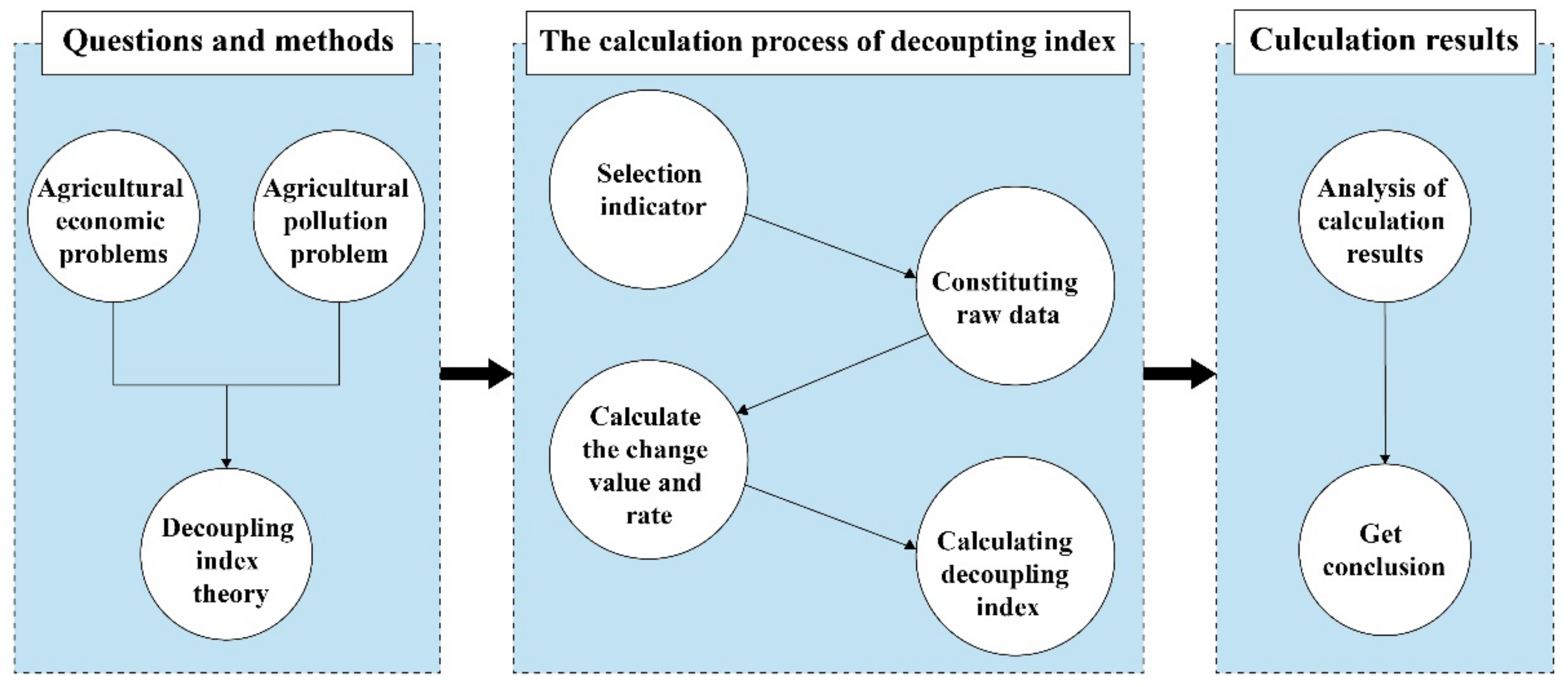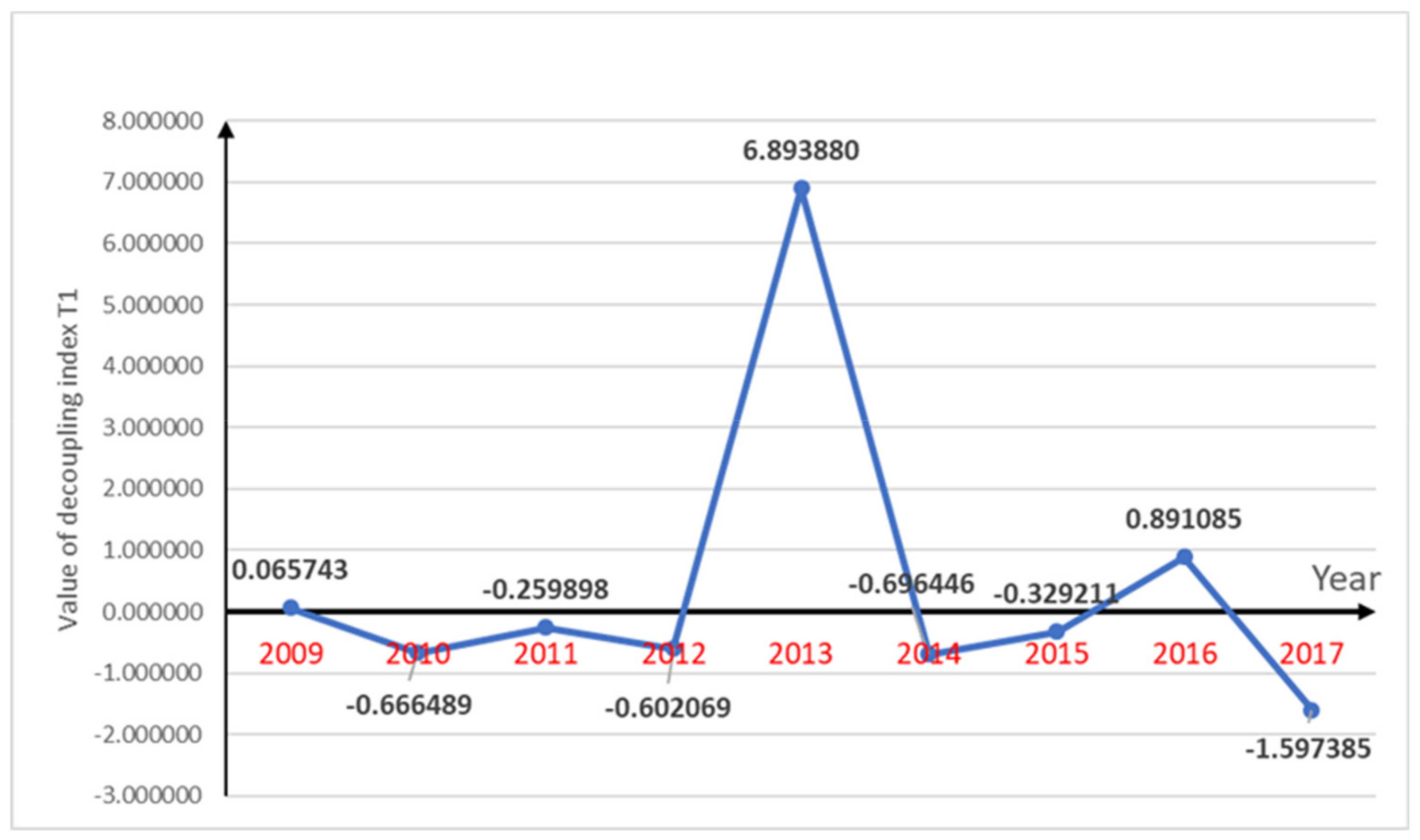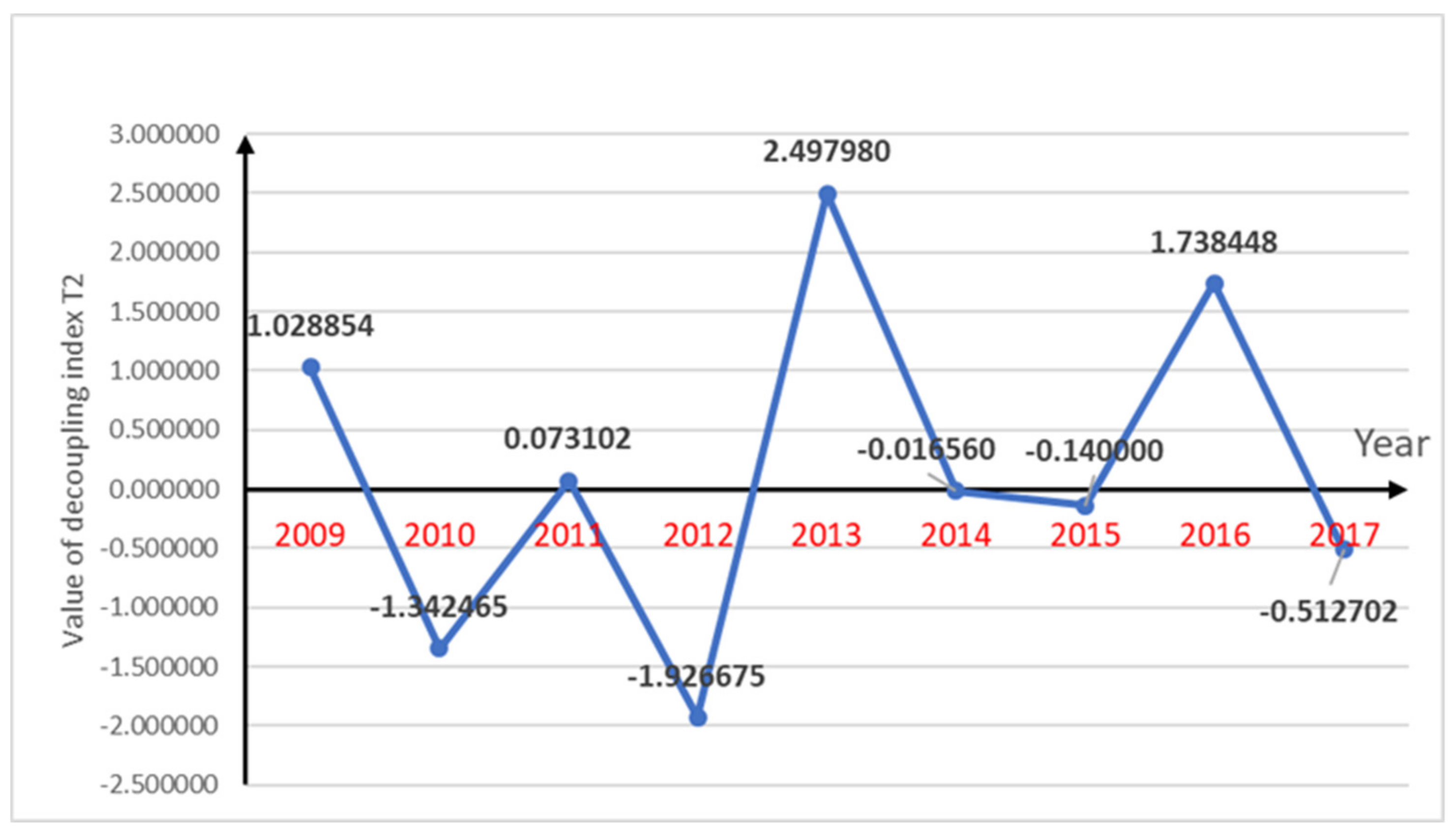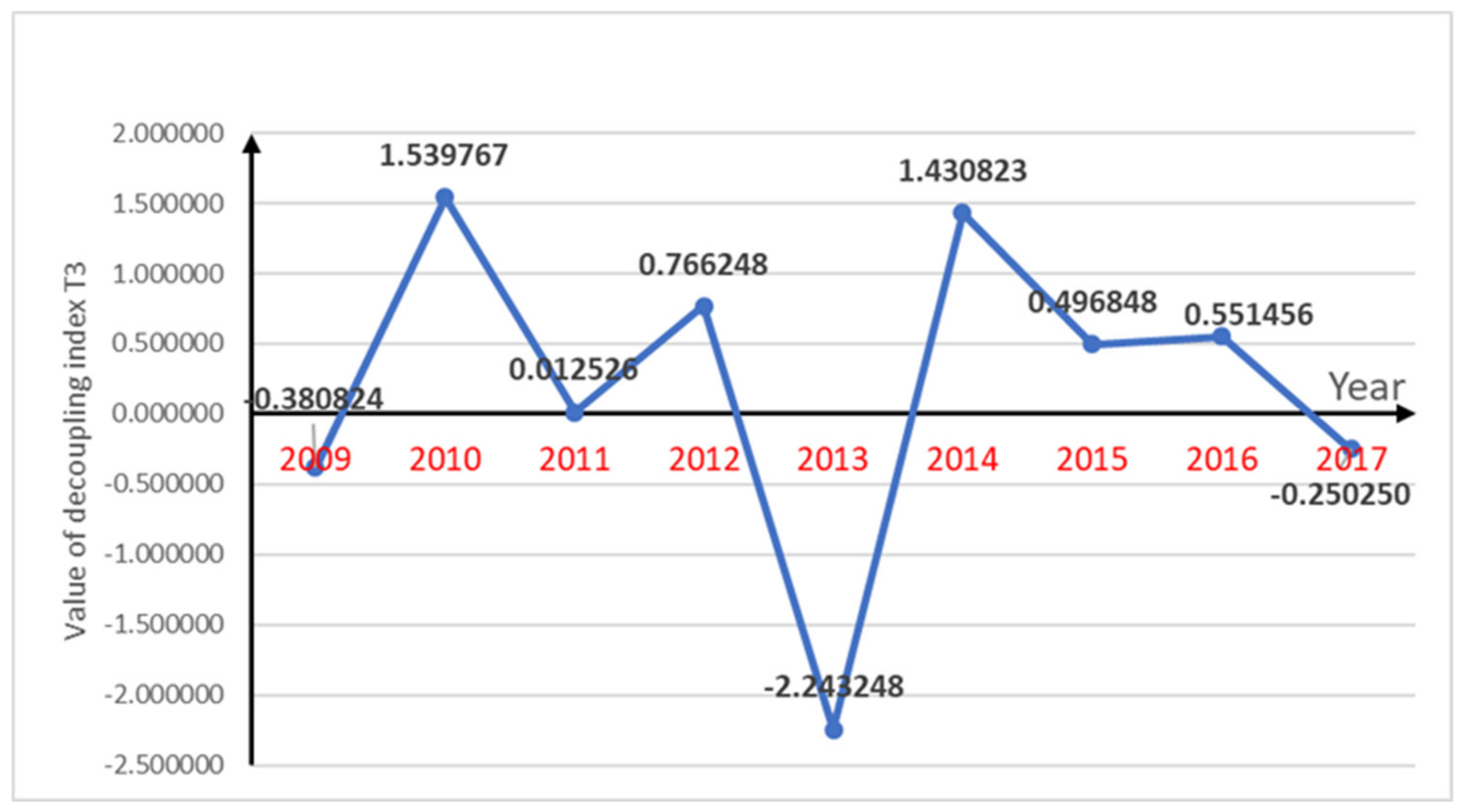Analysis of the Agricultural Economy and Agricultural Pollution Using the Decoupling Index in Chengdu, China
Abstract
1. Introduction
2. Materials and Methods
2.1. Decoupling Exponential Model
2.2. Index Selection Logic
2.3. Measurement Method and Steps in the Decoupling Index
2.3.1. The Calculating Process and Formula of Decoupling Index
2.3.2. Calculating the Variation Values for the Indicators
2.3.3. Calculating the Decoupling Index for the Agricultural Economy and Agricultural Pollution
3. The Decoupling Index Calculation Results
3.1. Decoupling Index State Classification
3.2. Calculation Results
4. Discussion
4.1. Results Discussion
4.2. Results Analysis
5. Conclusions
Author Contributions
Funding
Conflicts of Interest
References
- Sun, Y.; Zhou, X. Research on the Impact of Heterogeneous Human Capital on China’s Agricultural Economic Growth: Based on Interprovincial Panel Data. J. Agrotech. Econ. 2015, 4, 108–119. [Google Scholar]
- Jiang, H. Achievement and Future Development Ideas of Modernization Construction in China’s Rural Areas since Reform and Opening-up. Issues Agric. Econ. 2018, 8, 51–59. [Google Scholar]
- Huang, H.; Bai, C.; Yi, X. Financial Exclusion, Agricultural Science and Technology Investment and Agricultural Economic Development. Manag. World 2018, 34, 67–78. [Google Scholar]
- Liu, Y. Prevention and Control Measures of Agricultural Pollution in China. Macroecon. Manag. 2008, 7, 58–60. [Google Scholar]
- Dou, Y.; Deng, Y.; Chen, S. Current Situation of Agricultural Environmental Pollution in China and Technological Innovation Path for Its Control. Sci. Manag. Res. 2016, 34, 76–79. [Google Scholar]
- Zhang, J.; Wang, J.; Zhou, X. Farm Machine Use and Pesticide Expenditure in Maize Production: Health and Environment Implications. Int. J. Environ. Res. Public Health 2019, 16, 1808. [Google Scholar] [CrossRef]
- Tapio, P. Towards a theory of decoupling: Degrees of decoupling in the EU and the case of road traffic in Finland between 1970 and 2001. Transp. Policy 2005, 12, 137–151. [Google Scholar] [CrossRef]
- Qiu, F.; Shen, Z.; Zhang, J. Dynamic Analysis of Sustainable Development of Coal City Based on Decoupling Model: A Case Study of Xuzhou City. Areal Res. Dev. 2011, 30, 67–72. [Google Scholar]
- Zhang, L.; Xue, B.; Geng, Y.; Ren, W.; Lu, C. Emergy-Based City’s Sustainability and Decoupling Assessment: Indicators, Features and Findings. Sustainability 2014, 6, 952–966. [Google Scholar] [CrossRef]
- Zhang, Z.; Xue, B.; Pang, J.; Chen, X. The Decoupling of Resource Consumption and Environmental Impact from Economic Growth in China: Spatial Pattern and Temporal Trend. Sustainability 2016, 8, 222. [Google Scholar] [CrossRef]
- Zhong, W.; Sun, Y.; Qing, D. Research on Decoupling relationship between economic growth, energy consumption and carbon dioxide emissions. J. Audit Econ. 2012, 27, 99–105. [Google Scholar]
- Yi, P.; Fang, S.; Ma, C. Decoupling Evaluation of Tourism Economic Growth and Eco-environmental Pressure in Geoparks: A Case Study of Songshan Mountain World Geopark. J. Nat. Resour. 2014, 29, 1282–1296. [Google Scholar]
- Liu, Q.; Nai, L.; Ou, M. Target Analysis of Total Construction Land Management and Control in China Based on Decoupling Scenario. J. Nanjing Agric. Univ. 2014, 14, 80–85. [Google Scholar]
- Yin, Y.; Yang, X. Research on the Coupling Relationship between Technological Innovation and Energy Consumption in Manufacturing Industry. Sci. Technol. Manag. Res. 2014, 34, 231–235. [Google Scholar]
- Zhang, W.; Li, G. Research on Regional Economic Growth and Sustainability in China: Based on Decoupling Index Analysis. Econ. Geogr. 2015, 35, 8–14. [Google Scholar]
- Long, L.; Wang, X. A Study on the Relationship among Ecological Loss, Economic Growth and Welfare Level in the Process of Urbanization in China: Based on Tapio Decoupling Analysis and Granger Causality Test. Inq. Into Econ. Issues 2017, 3, 98–106. [Google Scholar]
- Moutinho, V.; Fuinhas, J.A.; Marques, A.C.; Santiago, R. Assessing eco-efficiency through the DEA analysis and decoupling index in the Latin America countries. J. Clean. Prod. 2018, 205, 512–524. [Google Scholar] [CrossRef]
- Qiu, L.; Huang, J.; Niu, W. Decoupling and Driving Factors of Economic Growth and Groundwater Consumption in the Coastal Areas of the Yellow Sea and the Bohai Sea. Sustainability 2018, 10, 4158. [Google Scholar] [CrossRef]
- Conrad, E.; Cassar, L. Decoupling Economic Growth and Environmental Degradation: Reviewing Progress to Date in the Small Island State of Malta. Sustainability 2014, 6, 6729–6750. [Google Scholar] [CrossRef]
- Wang, Z.; Zhao, L.; Mao, G.; Wu, B. Eco-Efficiency Trends and Decoupling Analysis of Environmental Pressures in Tianjin, China. Sustainability 2015, 7, 15407–15422. [Google Scholar] [CrossRef]
- Jiang, X.T.; Dong, J.F.; Wang, X.M.; Li, R.R. The Multilevel Index Decomposition of Energy-Related Carbon Emission and Its Decoupling with Economic Growth in USA. Sustainability 2016, 8, 857. [Google Scholar] [CrossRef]
- Liu, C.; Zhang, M.; Huang, G. Decoupling Relationship Between Industrial Growth and Carbon Emissions in Shanxi Province. Technol. Econ. 2012, 31, 63–67. [Google Scholar]
- Zhang, Y. Research on the Decoupling Distribution of Energy Consumption, Carbon Dioxide Emissions and Sustainable Development of China’s Industry. Res. Dev. 2013, 1, 104–108. [Google Scholar]
- Xiang, L.; Hu, L. Decoupling Analysis of Regional High-tech Industry Cluster and Ecological Environment. Forum Sci. Technol. China 2017, 06, 101–108. [Google Scholar]
- Jiao, G.; Yan, M. Research on the Impact of Urbanization on Carbon Intensity in China: Based on Decoupling Index and Association Rules. Mod. Econ. Sci. 2017, 39, 79–86. [Google Scholar]
- Wenbo, G.; Yan, C. Assessing the efficiency of China’s environmental regulation on carbon emissions based on Tapio decoupling models and GMM models. Energy Rep. 2018, 4, 713–723. [Google Scholar] [CrossRef]
- Li, H.; Yuan, J.; Feng, J. Research on the Decoupling Relationship between Human Welfare and Natural Consumption in China and Its Influencing Factors. Forum Sci. Technol. China 2018, 3, 135–142. [Google Scholar]
- Zhang, L.; Kou, C.; Zheng, J.; Li, Y. Decoupling Analysis of CO2 Emissions in Transportation Sector from Economic Growth during 1995–2015 for Six Cities in Hebei, China. Sustainability 2018, 10, 4149. [Google Scholar] [CrossRef]
- Wang, Q.; Li, R.; Jiang, R. Decoupling and Decomposition Analysis of Carbon Emissions from Industry: A Case Study from China. Sustainability 2016, 8, 1059. [Google Scholar] [CrossRef]
- Shang, W.; Pei, G.; Walsh, C.; Meng, M.; Meng, X. Have Market-oriented Reforms Decoupled China’s CO2 Emissions from Total Electricity Generation? An Empirical Analysis. Sustainability 2016, 8, 468. [Google Scholar] [CrossRef]
- Zheng, J.; Hu, Y.; Dong, S.; Li, Y. The Spatiotemporal Pattern of Decoupling Transport CO2 Emissions from Economic Growth across 30 Provinces in China. Sustainability 2019, 11, 2564. [Google Scholar] [CrossRef]
- Yang, H.; Ma, X. Uncovering CO2 Emissions Patterns from China-Oriented International Maritime Transport: Decomposition and Decoupling Analysis. Sustainability 2019, 11, 2826. [Google Scholar] [CrossRef]
- Chengdu Statistical Bureau. Chengdu Statistical Yearbook; China Statistics Press: Beijing, China, 2008–2017.
- OECD. Effects of Quantitative Constraints on the Degree of Decoupling of Crop Support Measures; OECD: Paris, France, 2005. [Google Scholar]
- Li, M.; Wang, J.; Chen, Y. Evaluation and Influencing Factors of Sustainable Development Capability of Agriculture in Countries along the Belt and Road Route. Sustainability 2019, 11, 2004. [Google Scholar] [CrossRef]
- Zahm, F.; Viaux, P.; Vilain, L.; Girardin, P.; Mouchet, C. Assessing farm sustainability with the IDEA method—From the concept of agriculture sustainability to case studies on farms. Sustain. Dev. 2008, 16, 271–281. [Google Scholar] [CrossRef]
- Jia, L.; Wang, W.; Li, Y.; Yang, L. Heavy Metals in Soil and Crops of an Intensively Farmed Area: A Case Study in Yucheng City, Shandong Province, China. Int. J. Environ. Res. Public Health 2010, 7, 395–412. [Google Scholar] [CrossRef]




| Year | Per Capita Gross Agricultural Production Value/Yuan | Pesticide Use/(Tons) | Agricultural Fertilizer Application/(10,000 Tons) | Agricultural Plastic Film Usage/(Tons) |
|---|---|---|---|---|
| 2008 | 4153 | 6145 | 19.79 | 9505 |
| 2009 | 3896 | 6120 | 18.53 | 9729 |
| 2010 | 4109 | 5897 | 17.17 | 10,548 |
| 2011 | 4731 | 5665 | 17.36 | 10,568 |
| 2012 | 4946 | 5510 | 15.84 | 10,936 |
| 2013 | 4921 | 5318 | 15.64 | 11,060 |
| 2014 | 5111 | 5175 | 15.63 | 11,671 |
| 2015 | 5438 | 5066 | 15.49 | 12,042 |
| 2016 | 6062 | 5584 | 18.58 | 12,804 |
| 2017 | 6202 | 5378 | 18.36 | 12,730 |
| Year | Per Capita Gross Agricultural Production Value/Yuan | Pesticide Use/(Tons) | Agricultural Fertilizer Application/(10,000 Tons) | Agricultural Plastic Film Usage/(Tons) |
|---|---|---|---|---|
| 2009 | −257 | −25 | −1.26 | 224 |
| 2010 | 213 | −223 | −1.36 | 819 |
| 2011 | 622 | −232 | 0.19 | 20 |
| 2012 | 215 | −155 | −1.52 | 368 |
| 2013 | −25 | −192 | −0.2 | 124 |
| 2014 | 190 | −143 | −0.01 | 611 |
| 2015 | 327 | −109 | −0.14 | 371 |
| 2016 | 624 | 518 | 3.09 | 762 |
| 2017 | 140 | −206 | −0.22 | −74 |
| Year | ||||
|---|---|---|---|---|
| 2009 | −0.061883 | −0.004068 | −0.063669 | 0.023567 |
| 2010 | 0.054671 | −0.036438 | −0.073394 | 0.084181 |
| 2011 | 0.151375 | −0.039342 | 0.011066 | 0.001896 |
| 2012 | 0.045445 | −0.027361 | −0.087558 | 0.034822 |
| 2013 | −0.005055 | −0.034846 | −0.012626 | 0.011339 |
| 2014 | 0.038610 | −0.026890 | −0.000639 | 0.055244 |
| 2015 | 0.063980 | −0.021063 | −0.008957 | 0.031788 |
| 2016 | 0.114748 | 0.102250 | 0.199484 | 0.063279 |
| 2017 | 0.023095 | −0.036891 | −0.011841 | −0.005779 |
| Year | 2009 | 2010 | 2011 | 2012 | 2013 | 2014 | 2015 | 2016 | 2017 |
|---|---|---|---|---|---|---|---|---|---|
| 0.065743 | −0.666489 | −0.259898 | −0.602069 | 6.893880 | −0.696446 | −0.329211 | 0.891085 | −1.597385 | |
| 1.028854 | −1.342465 | 0.073102 | −1.926675 | 2.497980 | −0.016560 | −0.140000 | 1.738448 | −0.512702 | |
| −0.380824 | 1.539767 | 0.012526 | 0.766248 | −2.243248 | 1.430823 | 0.496848 | 0.551456 | −0.250250 |
| Status | Index | |||
|---|---|---|---|---|
| Negative Decoupling | expansive | >0 | >0 | > 1.2 |
| strong | >0 | <0 | < 0 | |
| weak | <0 | <0 | 0 ≤ < 0.8 | |
| Decoupling | weak | >0 | >0 | 0 ≤ < 0.8 |
| strong | <0 | >0 | < 0 | |
| recessive | <0 | <0 | > 1.2 | |
| Connection | expansive | >0 | >0 | 0.8 ≤ ≤1.2 |
| recessive | <0 | <0 | 0.8 ≤ ≤1.2 | |
| Year | |||
|---|---|---|---|
| 2009 | weak negative decoupling | recessive connection | strong negative decoupling |
| 2010 | strong decoupling | strong decoupling | expansive negative decoupling |
| 2011 | strong decoupling | weak decoupling | weak decoupling |
| 2012 | strong decoupling | strong decoupling | weak decoupling |
| 2013 | recessive decoupling | recessive decoupling | strong negative decoupling |
| 2014 | strong decoupling | strong decoupling | expansive negative decoupling |
| 2015 | strong decoupling | strong decoupling | weak decoupling |
| 2016 | expansive connection | expansive negative decoupling | weak decoupling |
| 2017 | strong decoupling | strong decoupling | strong decoupling |
© 2019 by the authors. Licensee MDPI, Basel, Switzerland. This article is an open access article distributed under the terms and conditions of the Creative Commons Attribution (CC BY) license (http://creativecommons.org/licenses/by/4.0/).
Share and Cite
Li, S.; Gong, Q.; Yang, S. Analysis of the Agricultural Economy and Agricultural Pollution Using the Decoupling Index in Chengdu, China. Int. J. Environ. Res. Public Health 2019, 16, 4233. https://doi.org/10.3390/ijerph16214233
Li S, Gong Q, Yang S. Analysis of the Agricultural Economy and Agricultural Pollution Using the Decoupling Index in Chengdu, China. International Journal of Environmental Research and Public Health. 2019; 16(21):4233. https://doi.org/10.3390/ijerph16214233
Chicago/Turabian StyleLi, Sipan, Qunxi Gong, and Shaolei Yang. 2019. "Analysis of the Agricultural Economy and Agricultural Pollution Using the Decoupling Index in Chengdu, China" International Journal of Environmental Research and Public Health 16, no. 21: 4233. https://doi.org/10.3390/ijerph16214233
APA StyleLi, S., Gong, Q., & Yang, S. (2019). Analysis of the Agricultural Economy and Agricultural Pollution Using the Decoupling Index in Chengdu, China. International Journal of Environmental Research and Public Health, 16(21), 4233. https://doi.org/10.3390/ijerph16214233






